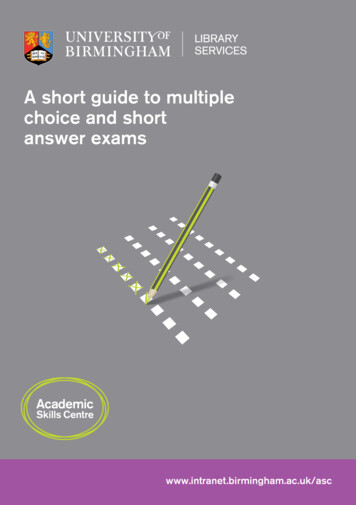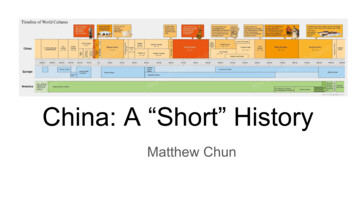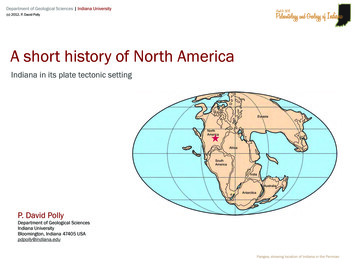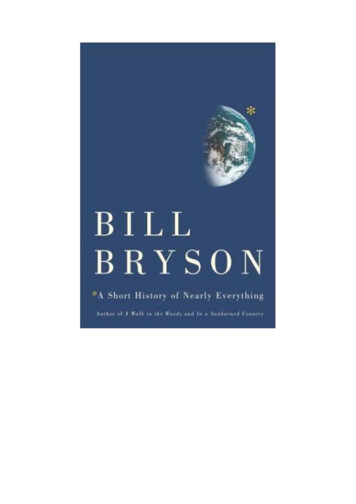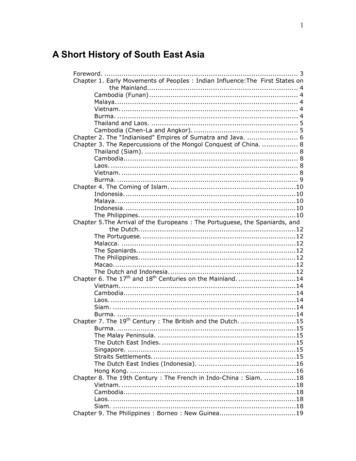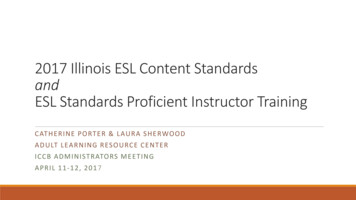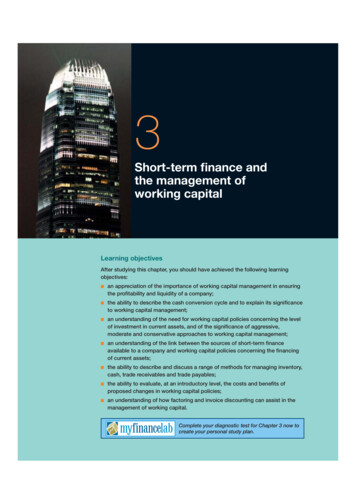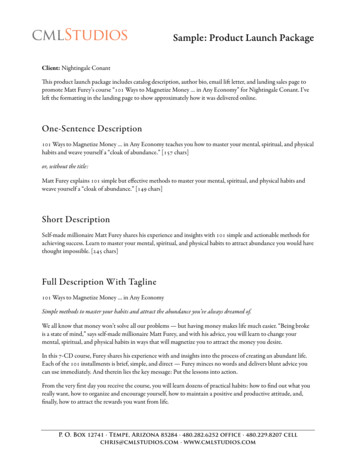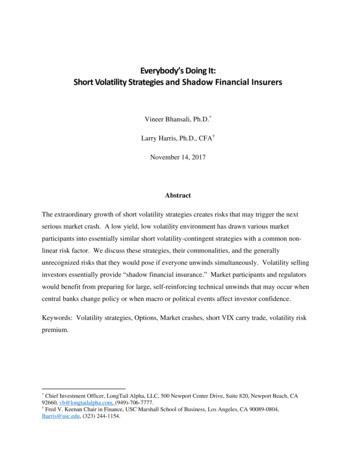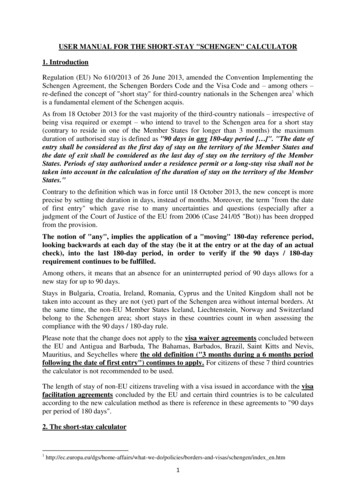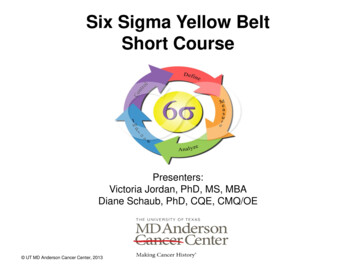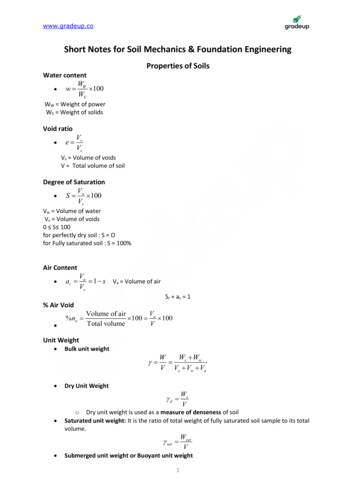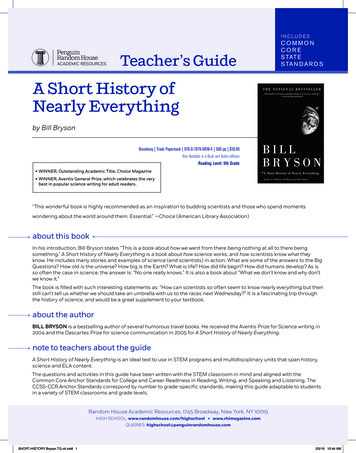
Transcription
I N C LU D E STeacher’s GuideCOMMONCORES TAT ES TA N D A R D SA Short History ofNearly Everythingby Bill BrysonBroadway Trade Paperback 978-0-7679-0818-4 560 pp 16.99Also Available in e-Book and Audio editionsReading Level: 9th Grade WINNER, Outstanding Academic Title, Choice Magazine WINNER, Aventis General Prize, which celebrates the verybest in popular science writing for adult readers.“This wonderful book is highly recommended as an inspiration to budding scientists and those who spend momentswondering about the world around them. Essential.” —Choice (American Library Association)about this bookIn his introduction, Bill Bryson states “This is a book about how we went from there being nothing at all to there beingsomething.” A Short History of Nearly Everything is a book about how science works, and how scientists know what theyknow. He includes many stories and examples of science (and scientists) in action. What are some of the answers to the BigQuestions? How old is the universe? How big is the Earth? What is life? How did life begin? How did humans develop? As isso often the case in science, the answer is: “No one really knows.” It is also a book about “What we don’t know and why don’twe know it.”The book is filled with such interesting statements as: “How can scientists so often seem to know nearly everything but thenstill can’t tell us whether we should take an umbrella with us to the races next Wednesday?” It is a fascinating trip throughthe history of science, and would be a great supplement to your textbook.about the authorBILL BRYSON is a bestselling author of several humorous travel books. He received the Aventis Prize for Science writing in2004 and the Descartes Prize for science communication in 2005 for A Short History of Nearly Everything.note to teachers about the guideA Short History of Nearly Everything is an ideal text to use in STEM programs and multidisciplinary units that span history,science and ELA content.The questions and activities in this guide have been written with the STEM classroom in mind and aligned with theCommon Core Anchor Standards for College and Career Readiness in Reading, Writing, and Speaking and Listening. TheCCSS-CCR Anchor Standards correspond by number to grade-specific standards, making this guide adaptable to studentsin a variety of STEM classrooms and grade levels.Random House Academic Resources, 1745 Broadway, New York, NY 10019HIGH SCHOOL: www.randomhouse.com/highschool www.rhimagazine.comQUERIES: son.TG.v4.indd 12/5/16 10:44 AM
This guide is an attempt to make this book a useful addition to your science curriculum in severalcourses. You will probably not use the entire book in any one class, but sections can be used formany different science classes. I have tried to identify the chapters that would be of interest toeach subject. Obviously, many chapters overlap and are of interest to several disciplines. The bookis probably most appropriate for high school and college students.In the guide, I have tried to list some of the Big Questions Bryson asks (and sometimes answers)in the book. Be warned: If you use this book in your class, you as a teacher will have to be willing tosay “I don’t know” in answer to students’ questions. Very often the answer to the questions listed inthe guide is “No one knows.” National Science Standards currently emphasize teaching Science asInquiry. The book is especially good at describing the history of science and “how science as inquiryworks.” It emphasizes that science is about questions, not answers, and that there are no easyanswers. Bryson does explain what we do know, and how we know it, but in a world where studentsare used to sound bites and easy answers, a book about thinking and questioning is important.In this reading guide, most chapters contain several types of Teaching Ideas and reading prompts:Demonstrations and Analogies: Descriptions of class demonstrations or analogies describedby Bryson to illustrate abstract ideas. These can be used as pre-reading class exercisesto increase interest in the chapters. As a Class Activity, enlist students to help with thesedemonstrations, either before or after reading.Statements to consider: Many of these are quotes from other books, or from scientists Brysoninterviewed. These can be used before reading to say, “Read the chapter to find out why he saysthis” or after reading to say, “What do you think?”Thinking questions: Many of these are the big, unanswered, interesting questions of science,and the chapter often examines how we know what we do know.Information based questions are included to help you find which chapters apply to yourcurriculum.organization of the book by subject:Astronomy: 1, 2, 3, 4Biology: 19–30Chemistry: 1, 2, 7– 12, 16 (gas laws, elements on earth), 17, 18 (properties of water), 22 (isotopes), 26Geology: 4–7, 12–15, 27Meteorology: 17, 27Oceanography: 17, 18Physics: 1, 2, 4, 11Mathematics: 1, 4, 26(Obviously, there is a lot of overlap between disciplines, so check out other chapters, too. Thebook includes an index to help you. )CCSS.ELA-LITERACY.CCRA.R.10 Read and comprehend complex literary and informationaltexts independently and proficiently.a list of the big questions from the entire book.Add “How do we know?” to all of them. Many are not answered because “we just don’t know.” How old is the universe? How did the universe begin?How big is the universe? What’s “outside” the universe? Is it “open” or “closed?”Where did the elements come from?Is there life on other worlds? Is life rare or “inevitable?”How old is the Earth? How big is the Earth?Where is the Earth in the universe?How do we know the earth’s crust is moving? How does that affect the world?How small is an atom? What is an atom?What is life made up of? What is a cell? What is the most successful life form on Earth?How diverse is life? How many species are there?Why/How did life begin? Why/How did it begin just once?2SHORT-HISTORY.Bryson.TG.v4.indd 22/5/16 10:44 AM
Why did the dinosaurs die out? What causes extinctions? How do extinctions affect life? What is DNA? Why is 97% of DNA “useless?” What is the “Human genome?” What is “human?” Why was our human evolution (or any evolution) “risky?” What influences the Earth’s climate? Why is today’s climate abnormal? What may be the effects of global warming? Why are there no “missing links” in the fossil record? Where did humans come from? What is our human ancestry? How did we migratearound the world? Why is your life amazing? Are we both the living universe’s supreme achievement and its worst nightmare?CCSS.ELA-LITERACY.CCRA.R.2 Determine central ideas or themes of a text andanalyze their development; summarize the key supporting details and ideas.CCSS.ELA-LITERACY.CCRA.R.3 Analyze how and why individuals, events, or ideasdevelop and interact over the course of a text.teaching ideas, discussions by chapter:introductionBryson lists some questions he considered when he was young, and then again the ones thatmade him want to write this book. What are the “Big Questions” you wish a science textbook wouldanswer?CCSS.ELA-LITERACY.CCRA.SL.1 Prepare for and participate effectively in a range ofconversations and collaborations with diverse partners, building on others’ ideas andexpressing their own clearly and persuasively.chapter �————Demonstration: Put TV on a blank station and watch the birth of the universe.CCSS.ELA-LITERACY.CCRA.SL.2 Integrate and evaluate information presented indiverse media and formats, including visually, quantitatively, and orally.Statement to consider: Biologist J.B.S. Haldane once observed, “The universe is not only queererthan we suppose, it is queerer than we can suppose.”1. How small is a proton?2. How small was the “singularity” that began the universe? What was “outside” it?3. How did the universe begin?4. How long did it take to go from there being “nothing” to being “stuff?”5. How old is the universe?6. What does the static on a blank TV station have to do with the Big Bang?7. Why is the universe “unlikely?”8. What is “outside” the universe?CCSS.ELA-LITERACY.CCRA.R.1 Read closely to determine what the text says explicitlyand to make logical inferences from it; cite specific textual evidence when writing orspeaking to support conclusions drawn from the text.CCSS.ELA-LITERACY.CCRA.R.2Determine central ideas or themes of a text andanalyze their development; summarize the key supporting details and ideas.3SHORT-HISTORY.Bryson.TG.v4.indd 32/5/16 10:44 AM
chapter �————Demonstration: Read the “Trip Across the Solar System.”Analogy: Solar system: If the Earth is the size of a pea, Jupiter is 1,000 feet away and Pluto is abacteria 1.5 miles away. The nearest star is 10,000 miles away!! Where is “here?” Where is the solarsystem in the universe?1. Is Pluto really a planet?2. How big is the solar system?3. What’s wrong with the picture of the solar system in most textbooks?4. What does a comet from the Oort cloud have to do with Manson, Iowa?5. Is there life on other planets? What is Drake’s Equation?CCSS.ELA-LITERACY.CCRA.R.1 Read closely to determine what the text says explicitlyand to make logical inferences from it; cite specific textual evidence when writing orspeaking to support conclusions drawn from the text.chapter �————Analogy or Demonstration: Scatter salt on a tablecloth, then change the tablecloth. This is whatEvans can do to find a new supernova (except on a parking lot full of tablecloths!)CCSS.ELA-LITERACY.CCRA.SL.2 Integrate and evaluate information presented indiverse media and formats, including visually, quantitatively, and orally.1. What is a supernova and why are they important to us?2. What would it be like if a star exploded near us?3. How are elements created? Where do the heavier elements come from?4. How does it feel to find out that you are made of “star stuff?”5. How was the solar system formed?6. Have you ever known anyone like Zwicky who had a big idea but didn’t know why it worked?7. Compare Evans’ method of finding a supernova to the new computerized methods. Which wouldyou prefer? Do you agree with Evans?CCSS.ELA-LITERACY.CCRA.R.1 Read closely to determine what the text says explicitlyand to make logical inferences from it; cite specific textual evidence when writing orspeaking to support conclusions drawn from the text.chapter �————Statement to consider: Newton’s Laws are the first universal laws of nature ever propounded by ahuman mind.CCSS.ELA-LITERACY.CCRA.R.8 Delineate and evaluate the argument and specific claimsin a text, including the validity of the reasoning as well as the relevance and sufficiency ofthe evidence.1. How big is the Earth?2. Why did a group of French Scientists go to Peru to measure the Earth?3. What is triangulation?4. How was trigonometry used to measure the Earth and the distance from Earth to Sun?5. How did a bet lead to the greatest mathematical book ever written?6. Is the Earth a perfect sphere? What does it matter?7. What is a transit of Venus?8. How do you measure the distance from Earth to the Sun?9. How do you “weigh” the Earth? How do you weigh another planet?10. How did Cavendish weigh the Earth?11. Why do you think Newton, Cavendish, and Gibbs were secretive about their discoveries?Compare them to others like Watson (26) (who was not secretive!).12. How did Triangulation help determine the size of the Earth? Distance of Earth to Sun? UseTriangulation to measure something around your school, like the height of a tree.4SHORT-HISTORY.Bryson.TG.v4.indd 42/5/16 10:44 AM
CCSS.ELA-LITERACY.CCRA.R.1 Read closely to determine what the text says explicitlyand to make logical inferences from it; cite specific textual evidence when writing orspeaking to support conclusions drawn from the text.CCSS.ELA-LITERACY.CCRA.R.2 Determine central ideas or themes of a text andanalyze their development; summarize the key supporting details and ideas.chapter �————Statement to consider: In the 19th century, we knew the “order” of ages, but had no idea how longany of those ages were!CCSS.ELA-LITERACY.CCRA.R.8 Delineate and evaluate the argument and specific claimsin a text, including the validity of the reasoning as well as the relevance and sufficiency ofthe evidence.1. How old is the Earth?2. Why does Bryson call Hutton’s book Theory of the Earth “maybe the least read important book inscience (if not for so many others)?”3. How do ancient fossil clamshells get to the mountaintops?4. How was this explained by 18th-century geology?5. What were the theories of plutonism and neptunism?6. How was this explained by 19th-century geology?7. What were the theories of Catastrophism and Uniformitarianism?8. Who was Lyell? Why was he called “the father of geologic thought?”9. How is geologic time divided and classified?10. Did geologists in the 19th century believe the earth was 6,000 years old (per Bishop Usher)?11. What were some of the attempts to determine age of Earth?12. How did Lord Kelvin undermine geology?13. Why do you think measuring the age of the Earth was so much more difficult than measuring itsmass or size?CCSS.ELA-LITERACY.CCRA.R.1 Read closely to determine what the text says explicitlyand to make logical inferences from it; cite specific textual evidence when writing orspeaking to support conclusions drawn from the text.CCSS.ELA-LITERACY.CCRA.R.2 Determine central ideas or themes of a text and analyzetheir development; summarize the key supporting details and ideas.CCSS.ELA-LITERACY.CCRA.R.4 Interpret words and phrases as they are used in a text,including determining technical, connotative, and figurative meanings, and analyze howspecific word choices shape meaning or tone.chapter �————1. Who were the great fossil hunters of the 19th century and what are their stories?2. What’s the story behind an unlucky man, an unscrupulous nasty man, and an American rivalry?3. Where was the first dinosaur fossil discovered?4. Why did Europeans in the 18th century disdain American animals?5. What was worrisome (at the time) about Cuvier’s original theory of extinctions?6. Why were fossils an important piece of geologic evidence?7. Why does Bryson consider Mantell “unlucky?”8. Why does Bryson consider Owen “unscrupulous?”9. How did a rivalry between Cope and Marsh help the study of dinosaurs and paleontology?10. What was the problem with the number of fossils and geologic eras and extinctions and theproposed age of the Earth?11. Why was the age of the Earth still thought to be 20–200 million years?CCSS.ELA-LITERACY: See above, Chapter 5 standards apply to Chapter 6.5SHORT-HISTORY.Bryson.TG.v4.indd 52/5/16 10:44 AM
chapter �————Statement to consider: “In late 18th century . . . Scientists everywhere searched for and sometimesbelieved they had actually found things that just weren’t there” (like elan vital).CCSS.ELA-LITERACY.CCRA.R.8 Delineate and evaluate the argument and specificclaims in a text, including the validity of the reasoning as well as the relevance andsufficiency of the evidence.1. Why is The Periodic Table of the Elements called “the most elegant organizational chart everdevised?”2. How old is the Earth?3. What are the elements and how were they discovered?4. How did a Swedish pharmacist discover eight elements and why have you never heard of him?5. What is alchemy?6. What was elan vital?7. How did a French noble (and his wife) “found” chemistry, and then get beheaded?8. What was the “drug of choice” in the early 19th century? How did this drug lead to the death of afamous chemist?9. How big is Avogadro’s number?10. How did a card playing, crazed looking Russian chemist bring order to chaos?11. Why is chemistry broken up into organic and inorganic?12. What is radioactivity and what does it have to do with the age of the earth?13. How did radioactivity undermine Lord Kelvin’s age of the earth?14. What is the current estimate for the age of the Earth?CCSS.ELA-LITERACY.CCRA.R.1 Read closely to determine what the text says explicitly andto make logical inferences from it; cite specific textual evidence when writing or speaking tosupport conclusions drawn from the text.CCSS.ELA-LITERACY.CCRA.R.2 Determine central ideas or themes of a text and analyze theirdevelopment; summarize the key supporting details and ideas.chapter �————Analogy: If galaxies were the size of peas, there are enough galaxies to fill the old Boston Garden.CCSS.ELA-LITERACY.CCRA.R.5 Analyze the structure of texts, including how specificsentences, paragraphs, and larger portions of the text (e.g., a section, chapter, scene, orstanza) relate to each other and the whole.1. How old is the universe?2. How big is the universe?3. How many galaxies are there?4. Who is Gibbs, “the most brilliant man that most people have never heard of?” What did he do?5. Why did scientists think there was “not much left for scientists to do” in the late 19th century?6. What is quantum theory and why is it so strange?7. What does E mc2 mean and why is it so important?8. How does radioactivity work?9. What is relativity?10. Why do we think the universe is expanding?11. How were women used as “computers?”CCSS.ELA-LITERACY.CCRA.R.1 Read closely to determine what the text says explicitly andto make logical inferences from it; cite specific textual evidence when writing or speaking tosupport conclusions drawn from the text.CCSS.ELA-LITERACY.CCRA.R.2 Determine central ideas or themes of a text and analyze theirdevelopment; summarize the key supporting details and ideas.6SHORT-HISTORY.Bryson.TG.v4.indd 62/5/16 10:44 AM
chapter �————Analogy 1: The relative size of an atom is to a millimeter as a sheet of paper is to the Empire Statebuilding.Analogy 2: If an atom is the size of a cathedral, the nucleus is a fly, but the fly is many thousands oftimes heavier than the cathedral.CCSS.ELA-LITERACY.CCRA.R.5 Analyze the structure of texts, including how specificsentences, paragraphs, and larger portions of the text (e.g., a section, chapter, scene, orstanza) relate to each other and the whole.Statement to consider: “You probably contain about a billion atoms from Shakespeare.”1. How small is an atom?2. Why do you think Feynman said, “The most profound scientific statement ever made is ‘All thingsare made of atoms.’”3. Rutherford is often used as an example of a scientist who was looking for one thing but foundsomething else. Why?4. What is a quantum leap and why is it strange?5. The very small is called “an area of the universe our brains just aren’t wired to understand.” Whydo you think that is?6. Why are the rules governing the very small different from the rules governing what we can see?CCSS.ELA-LITERACY.CCRA.R.1 Read closely to determine what the text says explicitly andto make logical inferences from it; cite specific textual evidence when writing or speaking tosupport conclusions drawn from the text.CCSS.ELA-LITERACY.CCRA.R.2 Determine central ideas or themes of a text and analyzetheir development; summarize the key supporting details and ideas.CCSS.ELA-LITERACY.CCRA.R.3 Analyze how and why individuals, events, or ideas developand interact over the course of a text.chapter ��———1. How old is the Earth?2. What is radiocarbon dating? What is radioactive dating? What forms of radioactive dating areused to determine the age of the Earth?3. Why is it a good thing that your car uses unleaded gasoline?4. What does the determination of the age of the Earth have to do with unleaded gasoline?5. Why does Bryson say Thomas Midgley had “an instinct for the regrettable that was almostuncanny?” What did Midgley invent?6. What does Bryson think is the “worst invention of the 20th century?” Why?7. Why should you be aware of “who funded this scientific study?”8. Who is Claire Patterson and how did he help determine the age of the Earth?9. Research and discuss any other examples, such as the story of Tetraethyl lead, in which a largecorporation (or maybe government?) influences science reporting.CCSS.ELA-LITERACY.CCRA.R.1 Read closely to determine what the text says explicitly andto make logical inferences from it; cite specific textual evidence when writing or speaking tosupport conclusions drawn from the text.CCSS.ELA-LITERACY.CCRA.R.6 Assess how point of view or purpose shapes the content andstyle of a text.CCSS.ELA-LITERACY.CCRA.SL.1 Prepare for and participate effectively in a range ofconversations and collaborations with diverse partners, building on others’ ideas andexpressing their own clearly and persuasively.7SHORT-HISTORY.Bryson.TG.v4.indd 72/5/16 10:44 AM
chapter ��————Statement to consider: “Physics is a search for ultimate simplicity.”CCSS.ELA-LITERACY.CCRA.SL.1 Prepare for and participate effectively in a range ofconversations and collaborations with diverse partners, building on others’ ideas andexpressing their own clearly and persuasively.1. How old is the universe?2. What is the connection between tiny subatomic particles and the start of the universe?3. What is CERN? What is a cloud chamber?4. What are some of these subatomic particles?5. Can you keep breaking down subatomic particles forever?6. Why does Bryson quote: “It is almost impossible for the non-scientist to discriminate betweenthe legitimately weird and the outright crackpot?” What do you think of this statement?7. How can the universe be younger than its oldest stars?8. What is “dark matter”?CCSS.ELA-LITERACY.CCRA.R.1 Read closely to determine what the text says explicitly andto make logical inferences from it; cite specific textual evidence when writing or speaking tosupport conclusions drawn from the text.CCSS.ELA-LITERACY.CCRA.R.2 Determine central ideas or themes of a text and analyzetheir development; summarize the key supporting details and ideas.CCSS.ELA-LITERACY.CCRA.R.5 Analyze the structure of texts, including how specificsentences, paragraphs, and larger portions of the text (e.g., a section, chapter, scene, orstanza) relate to each other and the whole.CCSS.ELA-LITERACY.CCRA.R.6 Assess how point of view or purpose shapes the contentand style of a text.Bryson summarizes this section on p. 172: “We live in a universe whose age we can’t quite compute,surrounded by stars whose distances we don’t altogether know, filled with matter we can’t identify,operating in conformance with physical laws whose properties we don’t truly understand.”Is this statement frustrating to you? Or does it make you want to learn more? Are you annoyed thatBryson doesn’t “answer” the questions he poses?chapter ��———Statement to consider: In 1944, a book reviewer complained that Arthur Holmes “. . . presented thearguments [for continental drift] so clearly and compellingly that students might actually come tobelieve them.” What is the irony of that statement? Does it affect how you think science works?CCSS.ELA-LITERACY.CCRA.R.4 Interpret words and phrases as they are used in a text,including determining technical, connotative, and figurative meanings, and analyze howspecific word choices shape meaning or tone.Analogy: The European and North American plates are moving about as fast as your fingernailsgrow.1. What are “continental drift”, “sea floor spreading” and “plate tectonics?”2. Why was there such resistance to the idea of “continental drift?”3. What is the current evidence for plate tectonics?4. What was Pangaea?5. Where does all the sediment go?6. How fast are the European and North American plates moving?7. Is it a coincidence that Earth is the only planet with plate tectonics and the only planet with life?8. How do plate tectonics explain earthquakes, island chains, mountains, etc?9. What do we still not understand about plate tectonics?8SHORT-HISTORY.Bryson.TG.v4.indd 82/5/16 10:44 AM
CCSS.ELA-LITERACY.CCRA.L.4 Determine or clarify the meaning of unknown and multiplemeaning words and phrases by using context clues, analyzing meaningful word parts, andconsulting general and specialized reference materials, as appropriate.CCSS.ELA-LITERACY.CCRA.R.1 Read closely to determine what the text says explicitly andto make logical inferences from it; cite specific textual evidence when writing or speaking tosupport conclusions drawn from the text.CCSS.ELA-LITERACY.CCRA.R.2 Determine central ideas or themes of a text and analyze theirdevelopment; summarize the key supporting details and ideas.chapter ��———Analogy 1: Think of the Earth’s orbit as a kind of freeway on which we are the only vehicle, but whichis crossed regularly by pedestrians who don’t know enough to look before stepping off the curb.Analogy 2: In 1991, an asteroid passed the Earth at a distance of 106,000 miles—the cosmicequivalent of a bullet passing through one’s sleeve without touching the arm. It wasn’t noticed untilafter it passed the Earth.CCSS.ELA-LITERACY.CCRA.R.5 Analyze the structure of texts, including how specificsentences, paragraphs, and larger portions of the text (e.g., a section, chapter, scene, orstanza) relate to each other and the whole.1. How did the dinosaurs become extinct?2. What does a comet impact on Jupiter have to do with mass extinctions on Earth?3. What does a meteor crater in Iowa tell us about the extinction of the dinosaurs?4. How dangerous would it be if the Earth was hit by a meteor? Is there anything we could doabout it?5. How many species became extinct at the KT (Cretaceous Tertiary) boundary?6. Why was there such resistance to the connection between impacts and extinctions?CCSS.ELA-LITERACY.CCRA.R.1 Read closely to determine what the text says explicitly andto make logical inferences from it; cite specific textual evidence when writing or speaking tosupport conclusions drawn from the text.chapter ��———Analogy 1: If the Earth were the size of an apple, we haven’t broken the skin.Analogy 2: To attempt to drill the “mohole” (the discontinuity between crust and mantle) is “liketrying to drill a hole in the sidewalks of New York from atop the Empire State building using astrand of spaghetti.”CCSS.ELA-LITERACY.CCRA.L.5 Demonstrate understanding of figurative language, wordrelationships, and nuances in word meanings.Statement to consider: “We understand the interior of the Sun far better than we understand theinterior of the Earth.”CCSS.ELA-LITERACY.CCRA.SL.1 Prepare for and participate effectively in a range ofconversations and collaborations with diverse partners, building on others’ ideas andexpressing their own clearly and persuasively.1. What is the inside of the Earth like? How do we know? What difference does it make?2. How did the Earth get its crust?3. What does volcanic ash in Nebraska have to do with Yellowstone Park?4. How do we know the Earth’s interior has “layers?”5. Where were the largest earthquakes in history? How damaging were they?6. Where are earthquakes common?7. How is the Earth’s magnetic field formed? Why does it reverse from time to time?9SHORT-HISTORY.Bryson.TG.v4.indd 92/5/16 10:44 AM
8. Why would it be bad to lose the Earth’s magnetic field?9. Why can’t we predict earthquakes or volcanic eruptions?CCSS.ELA-LITERACY.CCRA.R.1 Read closely to determine what the text says explicitly andto make logical inferences from it; cite specific textual evidence when writing or speaking tosupport conclusions drawn from the text.CCSS.ELA-LITERACY.CCRA.R.2 Determine central ideas or themes of a text and analyze theirdevelopment; summarize the key supporting details and ideas.chapter ��———Statement to consider: “Life is infinitely more clever and adaptable than anyone had ever supposed. This is a good thing, for we live in a world that doesn’t altogether seem to want us here.”CCSS.ELA-LITERACY.CCRA.SL.1 Prepare for and participate effectively in a range ofconversations and collaborations with diverse partners, building on others’ ideas andexpressing their own clearly and persuasively.1. Identify a volcanic caldera 45 miles across, which has erupted about 100 times. (Its last eruptionwas 1,000 times greater than Mt. St. Helen’s.) The blast, two million years ago, produced enoughash to cover California to a depth of 20 ft. Where is this caldera located? (Answer: Yellowstone’svolcano)2. How do volcanic eruptions influence climate?3. How do we know that Yellowstone won’t erupt again? What would happen if it did?4. How did the Grand Teton Mountains form?5. How does a geyser work?6. What is the connection between Yellowstone and the human genome project?7. What is an “extremophile”?CCSS.ELA-LITERACY.CCRA.R.1 Read closely to determine what the text says explicitly andto make logical inferences from it; cite specific textual evidence when writing or speaking tosupport conclusions drawn from the text.CCSS.ELA-LITERACY.CCRA.R.2 Determine central ideas or themes of a text and analyze theirdevelopment; summarize the key supporting details and ideas.chapter ��———1. Why is there life on Earth (but apparently no where else in the solar system)?2. What are the dangers of being under water in a deep water dive? Why?3. What is “the bends”? What is dangerous about it? How can it be prevented?4. Why did John Scott Haldane expose himself to carbon monoxide?5. How and why did his son, J. S. B. Haldane, experience collapsed lun
A Short History of Nearly Everything is an ideal text to use in STEM programs and multidisciplinary units that span history, science and ELA content. The questions and activities in this guide have been wri
